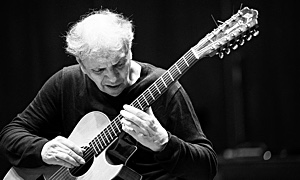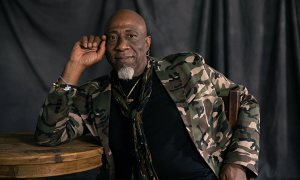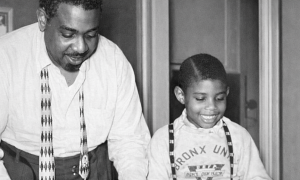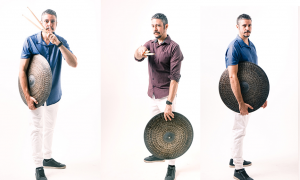Home » Jazz Articles » Interview » Tomasz Stanko: Lyricism and Liberation
Tomasz Stanko: Lyricism and Liberation
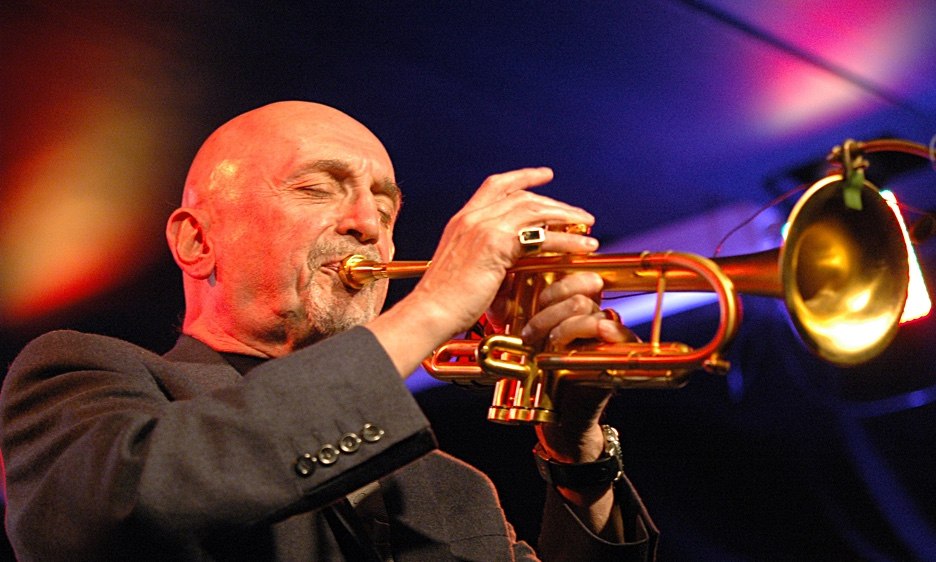
Courtesy John Kelman
Before I go to the studio I try to be completely empty. It's very dangerous if you have a routine and strong expectations because the end result is almost always completely different.
—Tomasz Stanko
Guitarist John Abercrombie, in a recent interview, discussed how as musicians age they seem to lean more towards the tradition, citing Italian trumpeter Enrico Rava as a prime example. Stańko has found the same pull happening to him. "As I get older," explains Stańko, "my musical direction is more communicative; there is more tradition in my music. In the last few years since Litania my music has been much closer to the tradition. I was thinking about this and it is probably a very natural process. When musicians are young they have a natural disposition towards novelty; they want to build their own language rather than build from tradition. Better to try something new, easier to build. But later, life, age and experiences dictate looking longer and more carefully at tradition."
Free Music
Stańko's early days were characterized by a free direction that was ably supported by his Polish compatriots, as well as associations with more experimental players including the late drummer/composer, Edward Vesala. "In the beginning I was a free player," Stańko says, "I was fascinated with Ornette [Coleman], all the new things that were happening at the time with George Russell and Cecil Taylor. Taylor played in Warsaw in '65 and used to hire me a lot. So my music was born from free jazz."But even in the early days of free music, Stańko's liberated music was characterized by a distinctive lyricism. His conception of free music was somehow different. "It's hard to put into concrete terms," says Stańko, "hard to define what freedom is. I think, for me, free music is more and more an idea ; not a style—although it is a style—but sometimes, for myself, it is better to know and respect a free conception in music, but not play too much. It's kind of dangerous to play only free music, especially if you like melodic stuff like I do. It's kind of dangerous because it's very easy to lose control in improvised music. Also, free music can easily be devaluated, at least in my experience. Of course if you have an artist like Cecil Taylor, freedom for him is different, more about energy and I respect him so much because of that.
"In the beginning I had a quintet with violinist Zbigniew Seifert," continues Stańko, "and we were playing totally free. But slowly, over time, this free music began to organize, and I thought, 'This is strange; why we organize more and more correctly.' Now, I'm in a place where I very much respect free music, but I don't play it too much."
Still, with records like Suspended Night, with an emphasis on melody and structure, there is an inherent freedom as well. "I'm born of freedom," Stańko explains, "and free music is like a child. I will always have freedom within my music. We play our recorded compositions much differently in concert, there's an evolution that comes from the freedom we have when we play.
"I like melodicism, I am pretty traditional," concludes Stańko, "I've been told that I'm a combination of lyricism and craziness, which I think is a good description because I'm very lyrical on one side and kind of wild on the other. These two elements are very strong in my music."
Matka Joanna and Leosia
The move towards a stronger lyrical bent has been gradual, just as the move away from free music has occurred over a long period of time. But it is the freedom that remains in his music that keeps it fresh; Stańko's music has the distinction of managing to sound new with every listen. Layers reveal themselves, making each listen sound like the first time. This quality began most notably with '94's Matka Joanna and continues to this day.The quartet that recorded Matka Joanna and '97's resplendent Leosia was originally meant to team Stańko with a group of all-Scandinavian musicians. Pianist Bobo Stenson and bassist Anders Jormin were onboard and, says Stańko, "the idea was to use Jon Christensen on drums, but he was busy; that was ultimately very good luck because I thought about whom I could arrange the session with and the idea of Tony Oxley came up. I had played with him many years ago at the end of the '60s, and I remembered that he was always a very free player; but he is one of those cats who knows the tradition, even though he doesn't like to use it. So I called him, we started to play and he was fantastic in the band because he was from a completely different background than Anders, and it gave the group a special kind of energy. Bobo was like the glue because he could play anything.
"That was a really interesting band for me," concludes Stańko, "but intriguingly we played more time in concert than we did on either of the records, which surprised me because Tony didn't like to play traditional music."
Litania
Following the dissolution of Stańko's first quartet, ECM label owner and producer Manfred Eicher came up with an idea that would produce one of Stańko's classic recordings. "Manfred asked me if I would think about recording some music from my early days in Poland with Krystof Komeda. Komeda was a famous film composer as well as a very original jazz composer; he wrote in closed form, not very typical for jazz music because it was more of a classical system. But he was very special; he inspired all of us to play in a more exact way."I remember in '65," continues Stańko, "we were playing at the Montmarte club in Copenhagen, and sometimes Don Cherry would join us because he was in the city and he really liked to play this music. Komeda gave us this predisposition for combining tradition and novelty; he was also into scalar music like Coltrane and Davis, but from this language he built his own language.
"So it was a fantastic idea," Stańko continues, "I was very lucky that Manfred proposed this. We discussed who would play on the session and made the band a little bigger than originally planned—from the original quintet we made it a sextet with two saxophones, trumpet, and rhythm section, with Terje Rypdal guesting on a few pieces. I took a sampling of Komeda's material; some from his soundtracks for Roman Polanski films like Knife in the Water and Rosemary's Baby, and two of his extended compositions for quintet; and that was Litania.
"Using Terje was also Manfred's idea," continues Stańko, "just to add some colour. We didn't know exactly what we were going to play, but we ultimately did three versions of 'Sleep Safe and Warm' and included all of them on the album because they were all so different and all so good; a real example of how different his compositions could be.
"And Jon Christensen; he's one of the great drummers," concludes Stańko. "Like Oxley he can be a beautiful free player, but he also has great time. He was especially good for the Komeda material because he's a melodic drummer—he can play the drums as a melodic instrument. We also chose Jon because he'd played with Bobo and Palle [Danielsson] in the past, so it was very organic; it was a great idea to have them all together on this session."
From the Green Hill
Stańko's next project, the genre-busting From the Green Hill, came out of an unexpected meeting between Stańko, saxophonist John Surman, violinist Michelle Makarski and bandoneon player Dino Saluzzi at an unusual ECM festival. "It was a very special all-acoustic environment," says Stańko, "a circular hall that was very much like a tower. We played the title track from Litania, with each of us in a different part of the hall. So we made this beautiful acoustic sound and the version of "Litania" was quite different, so we got the idea to make a record."The first idea," continues Stańko, "was to use Jon Christensen but only on percussion instruments; but when we got to the session we decided to have just drums, to get a more classical sound. I wrote music for it, we had a couple of days of rehearsal where we tried to get the sound together. John also wrote a very beautiful piece, 'Stone Ridge,' for Michelle. It was an interesting project because of the different colours we got by having musicians from different kinds of aesthetics. Michelle is a completely classical violin player; Dino is a little more of a jazz bandoneon player; John is simply special with colour. It was a very good band for colour, for sound; sound was always an important thing."
Current Quartet
Concurrent with Stańko's work with international musicians, he had been playing with a trio of young Polish musicians at home. Pianist Marcin Wasilewski, bassist Slawomir Kurkiewicz and drummer Michal Miskiewicz, who also function as a trio with the name Simple Acoustic Trio, were only sixteen when Stańko first began playing with them. "It was difficult to engage people like Bobo, Anders and Tony for smaller gigs in Poland," explains Stańko, "so I had to have a band. And I was very lucky; from the very beginning these guys played very, very well. They played jazz so well when they were young, great traditional jazz—they didn't play free music at first—but slowly they have grown in their ability to play free as well."It impressed me that, gig after gig, they were always getting better," continues Stańko. "I remember once I came back from doing some gigs with Bobo, Anders and Tony, and the next day I had gigs with them and, while I got a different feeling, it was just as good. So I started to play with them more, including concerts outside of Poland, and we gradually worked to where we are now."
Much has been written about how Stańko has groomed these young players, now in their mid-twenties, into the sympathetic and empathic group they are today. Stańko says otherwise. "I didn't do anything to groom them," says Stańko, "it's kind of a funny thing. When I was with Komeda we just had to play; with jazz it's important that you know how to teach yourself. If I play with good musicians we really don't have much rehearsal; we have concerts and then, after the gig, we talk things over. We may talk about freedom in music, but sometimes not just music, sometimes art and other things.
"It's important, when you are playing, that you are connected visually," continues Stańko. "It's not just about listening; it's about watching. There are small details, nuances that you pick up by watching."
Soul of Things and Suspended Night
The last two records with the Polish group, have been intriguing in that there are almost no song titles; with the exception of "Song for Sarah" on Suspended Night, all the pieces are numbered variations. "I think all my compositions are like one piece," explains Stańko. "They are very similar in fact; for example, I can build one composition from many compositions. The same way that people make remixes now; I can organically remix my own compositions. I can build a completely new composition by taking elements, for example, from three other compositions, because everything is interconnected, everything can go well together. Sometimes I can take a composition and change only the style, or differ the mood. Many of my compositions date back to the '60s and '70s. So Suspended Night's pieces are called variations because they are variations on pieces I have written at different times."There are many different ways you can play the same piece," continues Stańko. "My pieces can be very synthetic; you can always change the tempo and make them sound different."
Recording
Stańko credits Manfred Eicher with making important contributions to his recordings. "I think he shapes the result a lot," Stańko says. "I give a lot of space, a lot of freedom to the musicians. But it takes great talent and great power to build my music. Manfred, as a producer, has a special kind of aesthetic; a guy who has made a thousand great productions in his life, he must have something special inside. And I would be foolish not to use his experience and charisma; I try to use it the best I can. I like to have somebody's opinion, someone who can create some kind of atmosphere in the studio, nuances, touch—it's difficult to explain. He suggests very little, but every now and then comes up with something very special. On Balladyna, for example, it was his suggestion to play a very specific rhythm, and Dave Holland immediately came up with this phrase (sings), and we followed the idea."Stańko is often surprised by the results of his recording sessions. "I live for that," explains Stańko. "Before I go to the studio I try to be completely empty; it's very important to making it a fresh project. It's very dangerous if you have a routine and strong expectations, because the end result is almost always completely different from what you expect going in anyway. I like to work in this kind of situation. Sessions are always an evaluative process; I almost never know exactly how it will come out, but I am always optimistic and satisfied."
The Element of Surprise
It is the element of surprise in Stańko's work that keeps things fresh for him and, ultimately, for his audience. Freeing himself from preconception and musical constraints, while managing to move in a more traditional direction that is garnering him a growing audience, Stańko manages to mine the same themes repeatedly, while still making each listen a new experience.While special projects are not out of the question, Stańko's immediate plans are to continue working with his current quartet. And given the remarkable growth they have demonstrated in the time between Soul of Things and Suspended Night, it is clear that he will continue to build on a body of work characterized by lyrical compositional structures that still manage to retain a sense of musical liberation and unpredictability.
Tags
PREVIOUS / NEXT
Support All About Jazz
 All About Jazz has been a pillar of jazz since 1995, championing it as an art form and, more importantly, supporting the musicians who make it. Our enduring commitment has made "AAJ" one of the most culturally important websites of its kind, read by hundreds of thousands of fans, musicians and industry figures every month.
All About Jazz has been a pillar of jazz since 1995, championing it as an art form and, more importantly, supporting the musicians who make it. Our enduring commitment has made "AAJ" one of the most culturally important websites of its kind, read by hundreds of thousands of fans, musicians and industry figures every month.










